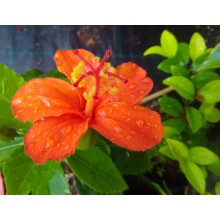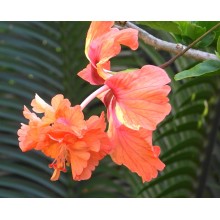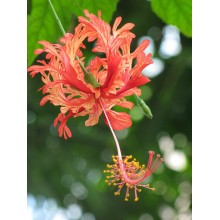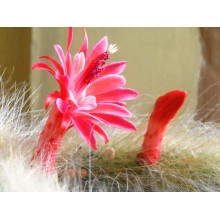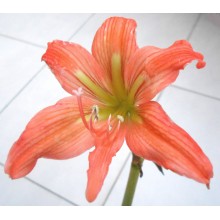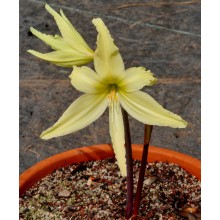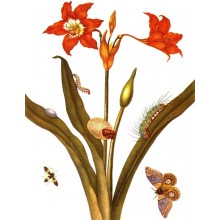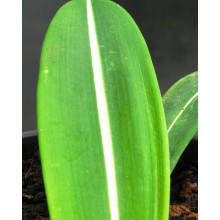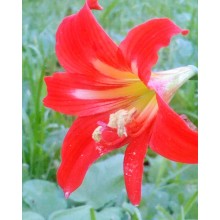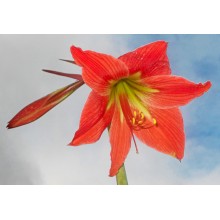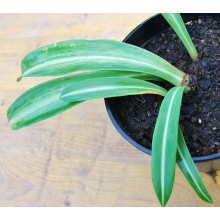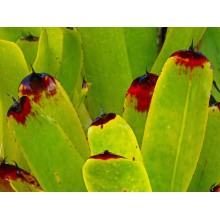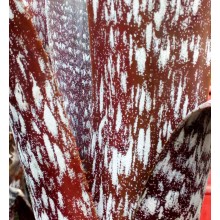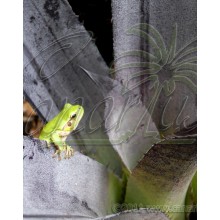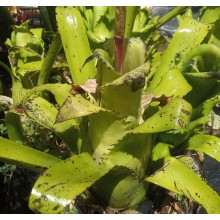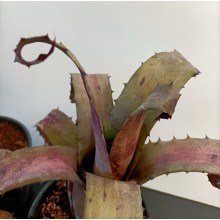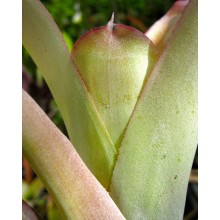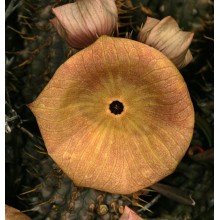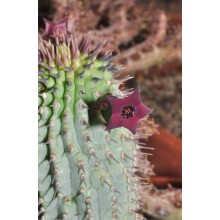Tutte le piante Ci sono 1884 prodotti.

Se vi piacciono le piante esotiche, allora sei nel posto giusto. Canarius offre le piante esotiche difficile da trovare che sono raramente disponibili in centri di giardinaggio. Il nostro negozio ha specie naturali e rari ibridi. Offriamo piante esotiche provenienti dalle Isole Canarie.
Gli ordini sono inviati a ovunque in Europa e anche in tutto il mondo. I pacchi raggiungeranno la vostra casa in pochi giorni dopo la spedizione (ma abbiamo bisogno anche alcuni giorni per l'elaborazione). Non esitate a contattarci se avete domande.
Sotto-categorie
-
Succulente
I deserti del mondo e le zone secche ospitano le piante più interessanti. Canarius offre una selezione crescente di piante succulente di massima qualità, perché sono coltivate all'aperto, in pieno sole delle Isole Canarie.
I succulente o "piante grasse" sono specie di ritenzione di acqua, adattate alle condizioni di asciutto. Loro accumulano succum (succo, acqua) nelle loro foglie, steli o radici, e spesso mostrano un aspetto robusto e carnoso.
-
Esotiche
Le piante esotiche sono specie provenienti da altre parti del mondo, e di solito hanno le qualità ornamentali: una vegetazione lussureggiante, fiori colorati, forme insolite... Qui è possibile trovare una grande varietà di piante esotiche: da bromeliacee e Heliconias, fino a palme e piante d'appartamento.
Le piante esotiche non hanno un uso particolare. I collettori acquistano questo tipo di piante per la loro rarità, per la decorazione interna o esterna, a seconda delle loro caratteristiche.
-
Da frutto & Per la salute
Le piante da frutto, erbe e piante medicinale sono concentrati su come ottenere una salute migliore. In questo contenuto della sezione, ogni tipo di pianta produce effetti salutari, entrambi alberi da frutto (Feijoa, Ananas, Fina Jete...) e piante per la salute, come Graviola, Aloe vera, Callisia fragrans... Nel normale metabolismo di tutti gli esseri viventi, l'organismo produce delle sostanze nutritive da latenti per l'ambiente; alcune di queste sostanze chimiche sono parte del processo in tutte le specie. Normalmente, i composti utili sono concentrati in alcune dei sue parti: foglie, semi, fiori...
-
Speciale
Su canarius.com cerchiamo di rimuovere i limiti nel campo della botanica. Sul nostro negozio online cerchiamo di facilitare l'acquisto / vendita di piante di tutto il mondo. Per questo motivo, coltiviamo piante di tutto il mondo, specie più comuni ed anche piante più particolari, come si può vedere in questa sezione.
-
Hibiscus rosa-sinensis 'El Capitolio Sport'
Hibiscus rosa-sinensis 'El Capitolio Sport'
Old, classic Hibiscus cultivar of unsurpassed beauty. Flowers are double, as a "flower within a flower" with lots of pink-orange shades. It originated as a sport of the red El Capitolio, and shares the same unusual flower shape and also the spreading growth habit with arching stems with few branches.
38,20 € -
Hibiscus schizopetalus
Hibiscus schizopetalus
Beautiful African Hibiscus with elegant drooping flowers with reflexed, "schizo" petals. It is an easy to grow shrub with ascending spreading branches. It is a tropical plant but it can be grown outdoors in the warmer coastal Mediterranean. Photo from Wikimedia Commons.
37,30 € -
Hildewintera colademononis
Hildewintera colademononis
Beautiful cactus from the Andes with hanging stems. They are "hairy", coated with a grey fur. Flowers are a show indeed! Cola de Mono means Monkey Tail and this is because each stem looks like the hanging tail of a hidden monkey! It is a high-elevation species and it is cool-growing and frost-tolerant.
13,50 € -
Hippeastrum blossfeldiae
Hippeastrum blossfeldiae
This Hippeastrum has delicate crimson flowers with a yellow throat. H. blossfeldiae is native to sandy coastal areas in South Brazil, not too far from Sao Paulo. It does not stand frost but it grows in cool conditions with no need of really hot weather.
12,50 € -
Hippeastrum evansiarum
Hippeastrum evansiarum
This wild Hippeastrum species builds large white-yellow flowers. The yellow colour is rare in this genus so this species has been used a lot to create new hybrids with some yellow.
56,00 € -
Hippeastrum puniceum
Hippeastrum puniceum
This bulb grows easily and produces abundant scarlet flowers with a very elegant shape. Their colour is hard to describe and hard to portrait in pictures, of a spectacular, bright, salmon-crimson orange.
12,20 € -
Hippeastrum reticulatum var. striatifolium
Hippeastrum reticulatum var. striatifolium
This is a lovely small species from SE. Brazil with the most unusual leaves in the genus: these are dark green with a bright white central stripe. Then it bears "reticulate" pink coloured flowers. This is the true wild species, not one of the hybrids commonly found in the trade under this name.
38,50 € -
Hippeastrum x 'Mrs Garfield'
Hippeastrum x 'Mrs Garfield'
Mrs. Garfield is an old hybrid made in the UK around 1880, between a Dutch Hippeastrum hybrid and the diminute H. reticulatum var. striatifolium.
19,30 € -
Hohenbergia castellanosii
Hohenbergia castellanosii
Mid sized bromeliad from the coastal restingas in Bahia, with an upright crown of lime-green wide leaves, eventually tipped in red. Young plants are all green, slightly mottled and tips become more and more red when the plant gets larger, especially if a bit stressed for sun, or cold. Then most of the leaves turn purple-red when the plant blooms.
57,00 € -
Hohenbergia disjuncta
Hohenbergia disjuncta
Bromeliad with urn-like rosettes holding leaves with a tipically blunt leaf apex. This hohenbergia is endemic to Bahia and produces long, drooping inflorescences with grouped bract.
28,10 € -
Hohenbergia leopoldo-horstii
Hohenbergia leopoldo-horstii
A black plant! This outstanding bromeliad for collectors grows on hot rocky mountains in Bahia, Brazil. Rosettes are almost black. The leaf colour is very dark purple, coated with silvery fuzz but it turns really black with age.
42,50 € -
Hohenbergia leopoldo-horstii Green
Hohenbergia leopoldo-horstii Green
Hohenbergia leopoldo-horstii is an outstanding exotic for collectors described in 1991 from Bahia, in NE Brazil. This bromeliad grows on hot rocky mountains at about 1000 m elevation. In this green form, leaves are pale green with abundant silvery and purplish tones depending on the exposition.
32,00 € -
Hohenbergia magnispina
Hohenbergia magnispina
Magnificent magnispina! This bromeliad slowly builds sculptural clumps of huge rosettes of an unreal grey-purple colour. The leaves are very exotic and still very formal in shape. It is found in the Chiapada Diamantina of Bahia, Brazile.
43,00 € -
Hohenbergia penduliflora
Hohenbergia penduliflora
This Caribbean Hohenbergia has wide leaves that turn red in cool winters. Inflorescences are pendulous, ornamental, long-lived, ending up with white and blue fruits. It is endemic to Cuba and somehow cold-tolerant.
38,70 € -
Hoodia gordonii
Hoodia gordonii
Beautiful branched Hoodia from Botswana, South Africa and Namibia. It has become also popular as a medicinal plant, since it reputedly works as an appetite suppressant.
26,30 € -
Hoodia mossamedensis
Hoodia mossamedensis
Purple-black, star-shaped flowers, with a flat corolla with recurved tips and a blackish corona.
41,00 €
Al momento ci sono pochi prodotti in questa categoria Tutte le piante




















